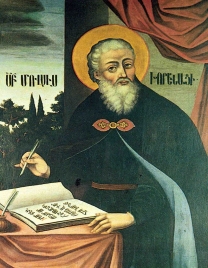Movses Khorenatsi
Tuesday, January 25, 2022
Movses Khorenatsi (ca. 410–490s AD) was a prominent Armenian historian from the period of Late Antiquity and the author of the History of the Armenians.
Movses is credited with the earliest known historiographical work on the history of Armenia written in Armenian, but was also a poet, or hymn writer, and a grammarian. The History of Armenia was written at the behest of Prince Sahak of the Bagratuni dynasty and has had an enormous impact on Armenian historiography. It was used and quoted extensively by later medieval Armenian authors. Although other Armenians such as Agathangelos had previously written histories on Armenia, Movses' work holds particular significance because it contains unique material on the old oral traditions in Armenia before its conversion to Christianity and, more importantly, traces Armenian history from Movses's day back to its origins.
Movses is considered to be the "father of Armenian history" (patmahayr), and is sometimes referred to as the "Armenian Herodotus." Movses's work became the first attempt of a universal history of Armenia.
Movses identified himself as a young disciple of Mesrop Mashtots, inventor of the Armenian alphabet, and is recognized by the Armenian Apostolic Church as one of the Holy Translators.
Early life and education
Movses' biographical details are given at the very end of the History of the Armenians but additional information provided by later medieval Armenian historians have allowed modern scholars to piece together additional information on him. Movses was believed to have been born in the village of Khorni (also spelled as Khoron and Khoronk) in the Armenian province of Taron or Turuberan sometime in 410. However, some scholars contend that if he was born here, he would have then been known as Movses of Khorneh or Khoron. They instead move the location of his birth from Taron to the Armenian province of Syunik, in the village of Khorena in the region of Harband.
He received his education in Syunik' and was later sent to be taught under the auspices of Mesrop Mashtots, the creator of the Armenian alphabet, and Catholicos Sahak Partev. In having considerable difficulty translating the Bible from Koine Greek to Classical Armenian, Mesrop and Sahak felt the need to send Movses and several of their other students to Alexandria, Egypt, at that time the center of education and learning, so that they themselves learn the Koine Greek and Syriac languages, as well as grammar, oratory, theology and philosophy.
Return to Armenia
The students left Armenia sometime between 432 and 435. First they went to Edessa where they studied at the local libraries. Then they moved towards Jerusalem and Alexandria. After studying in Alexandria for seven years, Movses and his classmates returned to Armenia, only to find that Mesrop and Sahak had died. Movses expressed his grief in a lament at the end of History of the Armenians:
While they awaited our return to celebrate their student’s accomplishments, we hastened from Byzantium, expecting that we would be dancing and singing at a wedding...and instead, I found myself grieving at the foot of our teachers' graves...I did not even arrive in time to see their eyes close nor hear them speak their final words.
To further complicate their problems, the atmosphere in Armenia that Movses and the other students had returned to was one that was extremely hostile and they were viewed with contempt by the native population. While later Armenian historians blamed this on an ignorant populace, Sassanid Persian policy and ideology were also at fault, since its rulers "could not tolerate highly educated young scholars fresh from Greek centers of learning." Given this atmosphere and persecution by the Persians, Movses went into hiding in a village near Vagharshapat and lived in relative seclusion for several decades.
Gyut, Catholicos of All Armenians (461–471), one day met Movses while traveling through the area and, unaware of his true identity, invited him to supper with several of his students. Movses was initially silent, but after Gyut's students encouraged him to speak, Movses made a marvelous speech at the dinner table. One of the Catholicos' students was able to identify Movses as a person Gyut had been searching for; it was soon understood that Gyut was one of Movses' former classmates and friends. Gyut embraced Movses and, being either a Chalcedonian Christian, or, at least, tolerant of them (since Movses was also Chalcedonian), brought his friend back from seclusion and appointed him to be a bishop in Bagrevan.
History of the Armenians
Serving as a bishop, Movses was approached by Prince Sahak Bagratuni (died in 482 during Charmana battle against Persian army), who, having heard of Movses' reputation, asked him to write a history of Armenia, especially the biographies of Armenian kings and the origins of the Armenian nakharar families. Armenian historian Artashes Matevosyan placed Movses' completion of History to the year 474 CE based on his research on the Chronicle by the sixth century Armenian historian Atanas Taronatsi.
One of his primary reasons for taking up Sahak Bagratuni's request is given in the first part of Patmutyun Hayots, or History of the Armenians: "For even though we are small and very limited in numbers and have been conquered many times by foreign kingdoms, yet too, many acts of bravery have been performed in our land, worthy of being written and remembered, but of which no one has bothered to write down." His work is a first historical record that covered the whole history of Armenia from a very ancient period until the death of the historian. His History served as a textbook to study the history of Armenia until the eighteenth century. Movses' history also gives a rich description of the oral traditions that were popular among the Armenians of the time, such as the romance story of Artashes and Satenik and the birth of the god Vahagn. Movses lived for several more years, and he died sometime in the late 490s CE.





